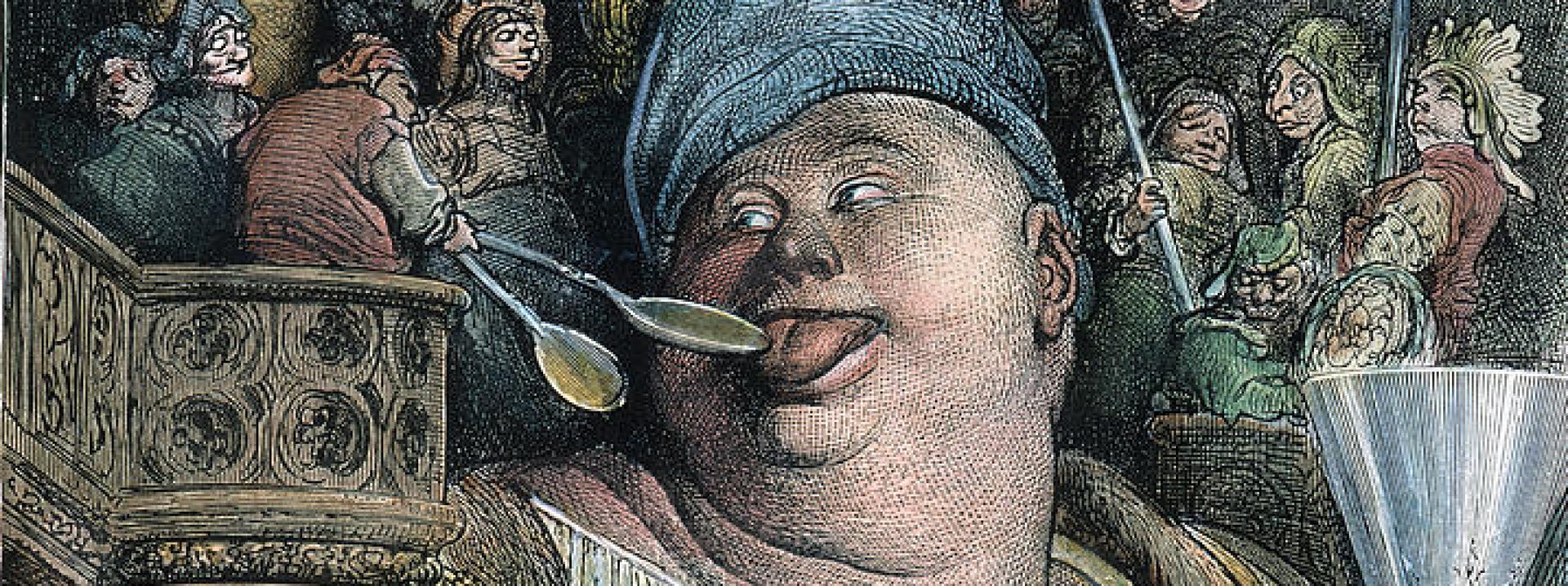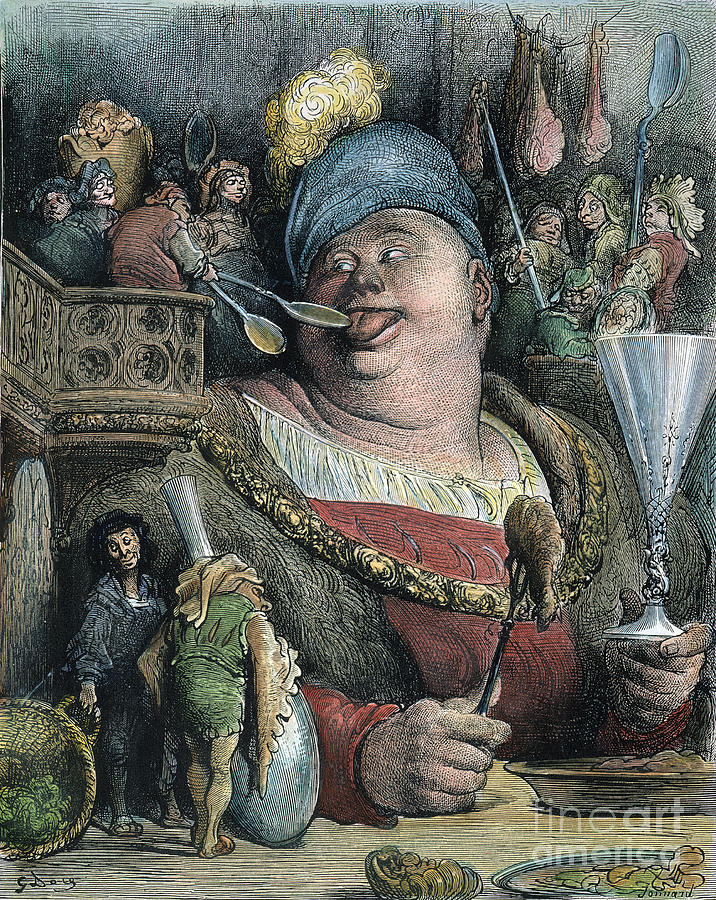Hey Class! I am focusing my appetizer on scenes of celebration and feast in movies and how they compare to the carnivalesque and grotesque that we’ve read about and seen in Bruegel paintings and in Rabelais. I want us to look at feast time and the ways it’s similar to Rabelais but also different. View the excerpts, paintings, and feast clips and make a comment.
Excerpts from Rabelais and His World
“But when carnival developed in the narrow sense of the word and became the center of all popular forms of amusement, it diminished all the other feasts and deprived them of almost every free and utopian folk element. The other feasts faded away; their popular character was reduced, especially because of their connection with ecclesiastic or political rituals. Carnival became the symbol and incarnation of the true folk festival, completely independent of Church and State but tolerated by them.” pg.220
“The feast is a primary, indestructible ingredient of human civilization; it may become sterile and even degenerate, but it cannot vanish. The private, “chamber” feast of the bourgeois period still preserves a distorted aspect of the ancient spirit; on feast days the doors of the home are open to guests, as they were originally open to “all the world.” On such days there is greater abundance in everything: food, dress, decorations. Festive greetings and good wishes are exchanged, although their ambivalence has faded. There are toasts, games, masquerades, laughter, pranks, and dances.” pg. 276
Here are a few links…..
Refresher on Bruegel Paintings
Carnival vs Lent:
http://insidebruegel.net/#p/v=udroom&lan=en&a=1016&x=s:3_l:1_v1:1016,vis
Peasant Dance
http://insidebruegel.net/#p/v=udroom&lan=en&a=1059&x=s:3_l:1_v1:1059,vis
Peasant Wedding
http://insidebruegel.net/#p/v=udroom&lan=en&a=1027&x=s:3_l:1_v1:1027,vis
Tolkien
The movies are based on books (The Hobbit,1937 Lord of the Rings,1950s) made by Tolkien(Link to wiki page). These movies have the folk imagery and feasts that Rabelais/Bahktin have discussed.
Movie Clips
Lord of the Rings(2001,2002,2003): Watch til 2mins
Watch these two clips and make comparisons to Bahktin’s carnival that we’ve read about. Do these scenes add to your understanding of carnival? Make viewing the movement within the Bruegel paintings in any way?


For some reason I wasn’t able to link to and watch the LOTR clip.
I really liked watching the Hobbit scene. While admittedly I don’t like the movie, I do think it helps me see the movement in Bruegel. As we have talked about in class, these paintings and the Carnival in general shouldn’t be viewed as something that is ever still. I think this clip helps with that. We see the movement of the dwarfs along with the singing and huge overabundance. Even the surrounding has the same kind of feel as the Bruegel. So I do feel this clip helps me understand Bruegel better.
I think bringing up movement is really insightful. I definitely tend to see pictures/paintings as still images and rarely see the movement and noise (as Hannah brings up) implied by the scene. Watching carnivalesque scenes, in movies for example, makes us think about still depictions of such scenes in a slightly more active way.
I was also unable to see the first clip! It said it was unavailable.
I really liked this comparison though, because we often have mentioned in class while looking at all different kinds of carnivalesque paintings (I’m thinking of Bruegel but also of some of the East-Asian paintings Chloe showed us, or pygmy paintings from the Roman world/Pompeii) where the people have differently shaped bodies. The big Hobbit feet and all of their short statures seem to stand out along with their chubbier build. They don’t seem nearly as carnivalesque/grotesque as some of the people in Bruegel or other painters! The noise and live motion give a real life to some of the paintings though, without which we can’t really experience in their full glory.
Sorry about that here is the link: https://www.youtube.com/watch?v=s2sVMLr1fDg
Yeah these movie clips add to the movement aspect when we see the Bruegel paintings and read Gargantua. Watch this clip and compare it to The Hobbit? Would you categorize both scenes as carnivalesque?
In one of the other appetizer groups, we talked about Harry Potter and the grotesque, but our conversation also turned to the carnivalesque. This reminds me a lot of Fred and George leaving Hogwarts (probably cause it’s two very similar looking red-heads blowing up fireworks?) I think that undermining a very powerful wizard such as Gandalf is great carnivalesque spirit. Other obvious factors such as the immense amount of food, booze, dancing, etc. stand out as well.
I like this comparison with Harry Potter. On a similar note, when I watched the LOTR scene it reminded me of the end scene of Star Wars: Return of the Jedi with the Ewoks celebrating fireworks and everything. I feel like there again I am able to get really into the scene and be happy with the characters.
The LOTR scene definitely feels Carnivalesque. Everyone is happy, dancing, drinking, and laughing. It seems very much like a festival the whole time. The Hobbit clip I feel differently about. While watching LOTR, I mostly feel excitement and like I am in the carnival fully, but with the Hobbit, Bilbo’s tension rubs off onto me. I never really felt into it. On the surface it is definitely Carnivalesque but since Bilbo is so miserable I don’t think it really is.
I agree. I think the aspect of the LOTR clip that makes it stand out from the Hobbit is how much the watcher feels include in the festivities. In this scene, our emotions match the emotions of the participants. We’re happy watching, and may even feel a little festive. In the Hobbit on the other hand, we pick up on Bilbo being flustered and may feel this way ourselves.
Right! And I think the tone of the whole thing changes a lot just a little later in the scene, with Bilbo giving (objectively) the best speech ever (“I don’t know half of you half as well as I should like, and I like less than half of you half as well as you deserve” absolutely destroys me every time I think about it.) When he disappears, there’s a lot of panic/worry as people realize this isn’t a trick and he’s really gone. I always found this a rather cruel joke to play. Even if he didn’t know or like many of his fellow hobbits, leaving without notice or a goodbye seems uncarnivalesque somehow.
I forgot to post this sooner.
Overall I enjoyed this presentation and the connection of the carnivalesque to modern media. It helps me to see visual examples of the carnivalesque and grotesque that we read in Rabelais. I originally wanted to to have more movies scenes but I decided to remain with Tolkien’s work because at first these two movies came to minds. I found the discussion of the LOTR clip interesting because the clip is still funny even when at times everyone doesn’t seem interested.